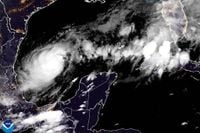As the 2025 Atlantic hurricane season intensifies, meteorologists and climate experts are raising urgent alarms over a critical loss in hurricane forecasting capabilities. Starting Monday, June 30, 2025, the U.S. government will cease the ingest, processing, and distribution of key microwave data from three weather satellites operated jointly by the National Oceanic and Atmospheric Administration (NOAA) and the Department of Defense (DoD). This data, collected through the Defense Meteorological Satellite Program (DMSP), has been vital for tracking hurricanes and predicting their rapid intensification—a phenomenon that can transform tropical storms into major hurricanes in a matter of hours.
Experts warn this sudden cutoff will severely degrade the accuracy of hurricane forecasts, placing tens of millions of Americans living along hurricane-prone coastlines at increased risk. University of Miami hurricane researcher Brian McNoldy described the loss as "alarmingly bad news," adding, "Microwave data are already relatively sparse, so any loss — even gradual as satellites or instruments fail — is a big deal; but to abruptly end three active functioning satellites is insanity." McNoldy further emphasized, "There is no sugar-coating it: hurricane forecasts will undoubtedly be worse after this loss. For anyone near a hurricane-prone area, this is alarmingly bad news."
The DMSP constellation, operational since the 1960s, provides specialized microwave sensor data that allows forecasters to peer inside storms, revealing three-dimensional structures hidden from traditional visible or infrared satellites. This capability is especially critical at night, when hurricanes often intensify rapidly. The microwave data helps pinpoint the exact location of a hurricane's center and detect rapid intensification events, which are notoriously difficult to predict but can dramatically increase a storm's destructive potential within hours.
Michael Lowry, a hurricane specialist and former scientist at NOAA’s National Hurricane Center, estimates that DMSP satellites account for roughly 50 percent of all microwave scans used in hurricane forecasting. He warned that losing this data will "greatly increase the odds of missing rapid intensification episodes, underestimating intensity, or misplacing the storm and degrading forecast accuracy." Lowry stated this will "severely impede and degrade hurricane forecasts for this season and beyond, affecting tens of millions of Americans who live along its hurricane-prone shorelines."
NOAA spokesperson Kim Doster called the data cutoff a "routine process of data rotation and replacement," assuring that remaining sources "are fully capable of providing a complete set of cutting-edge data and models that ensure the gold-standard weather forecasting the American people deserve." However, many meteorologists remain skeptical. Andy Hazelton, a hurricane modeling expert at the University of Miami, noted, "We don’t want to have less data for no reason," highlighting that the satellites are still functional and that no clear explanation has been given for the termination of data distribution.
James Franklin, retired branch chief at the National Hurricane Center, expressed concerns about the practical consequences: "Forecasters will see hourslong delays in recognizing that a storm has begun to strengthen abruptly," which could lead to delayed warnings and evacuations. He warned of the risk of "sunrise surprises," where storms appear manageable overnight before rapidly intensifying by dawn, leaving communities unprepared.
The timing of this data cutoff is particularly troubling given NOAA's forecast for an "extraordinary" 2025 hurricane season, predicting 13 to 19 named storms, 6 to 10 hurricanes, and 3 to 5 major hurricanes with winds exceeding 110 mph. Climate change, driving warmer ocean temperatures and stronger El Niño conditions, has already increased the frequency and intensity of rapid intensification events, making reliable data more critical than ever.
Beyond satellite data, the broader hurricane monitoring infrastructure is under strain. Budget cuts and staffing shortages have led to a historic collapse in America’s hurricane monitoring capabilities. The Pentagon has reduced flights of its critical C-130 "Hurricane Hunter" aircraft, which fly directly into storms to collect real-time intensity data. Meanwhile, hundreds of ocean buoys essential for measuring temperature, pressure, and wave height are going offline due to maintenance funding shortfalls. Newer technologies like gliders and dropsondes have been pulled back, further shrinking observational data.
Jordan Gerth, a meteorologist with NOAA’s Satellite and Information Service, warned, "We’re losing access to vital data. Without it, we can’t accurately model storm strength or track paths, which increases the risk to lives and property." University of Miami hurricane expert Brian McNoldy echoed this, stating, "The storm data deficit is real, and it’s growing. And if you reduce observations, your forecasts will get worse."
These cuts come amid bureaucratic tensions between NOAA, NASA, and the Pentagon, complicating efforts to modernize and maintain satellite systems. A planned satellite handoff from the DoD to NOAA has been delayed, and crucial programs like the Environmental Data Rescue Project have seen funding slashed. The White House’s fiscal 2026 budget request proposes severe cuts to climate and weather research programs, including the elimination of NOAA’s entire research arm.
The loss of DMSP data also threatens hurricane research and international weather monitoring. The satellites have provided a decades-long record of three-dimensional data on storm tracks, shapes, and behaviors, improving scientific understanding of hurricanes. Countries in the Caribbean and Mexico rely on U.S. storm forecasts for coastal and maritime safety. Subpar forecasts could lead to ships being lost at sea, as noted by meteorologists.
Canadian meteorologist Eddie Sheerr, who uses NOAA data daily, stressed its life-saving importance. He recounted using NOAA data in September 2022 to urge evacuation ahead of post-tropical storm Fiona, which devastated parts of Newfoundland. Sheerr fears that the data cuts will reduce forecast accuracy, making it harder to predict dangerous storms and their impacts.
Amid these challenges, voices from the scientific community are sounding the alarm. Hurricane researcher Jimmy Yunge wrote to NOAA’s Office of Satellite and Product Operations, stating bluntly, "This decision will kill people." The stakes could not be higher as the nation faces a hurricane season predicted to be more active and destructive than usual, with fewer tools to warn and protect vulnerable populations.
In summary, the termination of critical microwave data from the Defense Meteorological Satellite Program represents a severe blow to hurricane forecasting at a perilous moment. Experts warn that the loss will degrade forecast accuracy, delay warnings, and increase risks to millions. Coupled with broader cuts to observational infrastructure and staffing, the United States faces a dangerous gap in its ability to prepare for and respond to increasingly fierce storms fueled by climate change.






